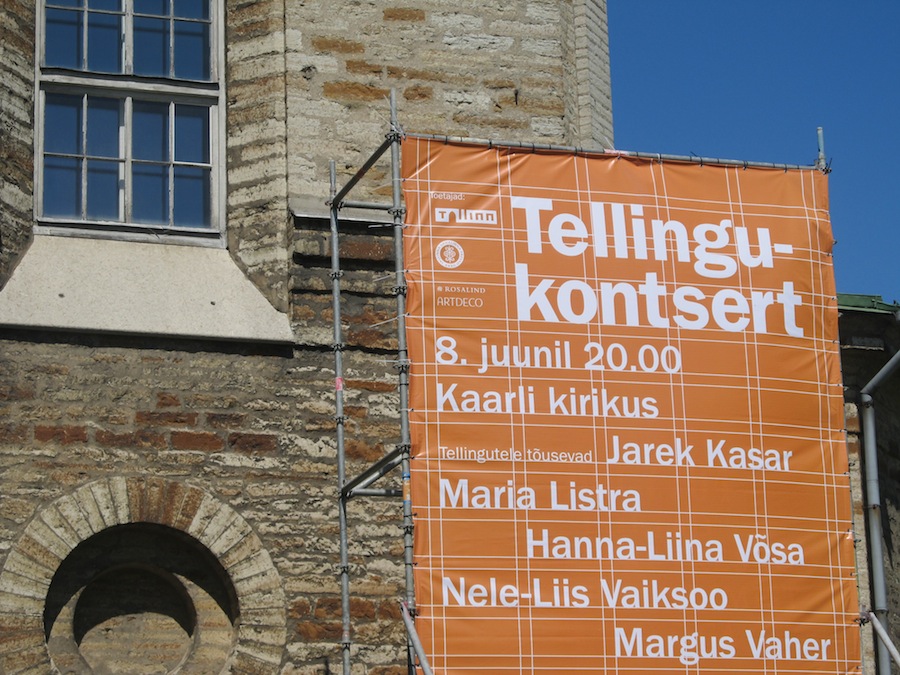Tellingutele tõusevad… The fine print at the bottom sums it up: Toetame koos Köleri altarimaali restaureerimist. Let's all support the restoration of Köler's altar painting.
Telling is a platform or scaffold. Usually used in the plural tellingud – scaffolding: a temporary structure for holding workers and materials during the erection, repair, or decoration of a building; a raised platform or stage for exhibiting spectacles, seating spectators, etc; or any raised framework. My handy etymological (word origin) dictionary tells me telling derives from the Low German stellinge and/or Swedish ställning. Nad tellisid tellingud. – they ordered scaffolding. (To order in German is bestellen.) The TELL- part has endured, as has the fresco on the ceiling of the apse (apsiid, apsiidi/võlv) above the altar of Kaarli kirik; for 130 years in fact. Now there are 14 metre high tellingud allowing restaureerijad access to Johann Köler's famed calling Christ, “Kutsuv Õnnistegija”, painted in 10 days in 1879. Köler derived inspiration from Bertel Thorvaldsen's sculpture of Christ with his arms outstretched in the cathedral of Kopenhaagen, Vor Frue Kirke (Church of Our Lady, Jumalaema kirikThe full title), but legend has it there may also be a good deal of similarity to a local man Villu, painted in Köler's youth.
Johann Köler (1826-1899) is considered Estonia's first professional painter who played a big part in the national awakening movement. The woman leading the current fresco restoration, Hilkka Hiiop likens Köler in this case to Michelangelo: “Here are his fingerprints, here are some hairs from his brush…” she enthuses over what has become exposed from under a century of dust. Kaarli kirik is essentially an island encircled by high traffic. This allows for admiration from all angles, but creates exorbitant amounts of dust and soot.
Why Kaarli? Who's Kaarel?
Tourism.tallinn.ee explains: “Tallinn's grandest 19th-century church, the Kaarli or Charles's (Karl XI) Lutheran Church, sets itself apart with its twin steeples, immense size and neo-Roman style. It was built from 1862 to 1882 as a long overdue replacement for the original Kaarli Church, founded in 1670 on the order of Sweden's King Charles (Karl) XI. Like many wooden structures located outside the city wall, the first Kaarli Church burned down during the Great Northern War in the early 1700s. Architect Otto Pius Hippius from St. Petersburg built the present limestone church using a special arch technique that gave it have a vast, open interior. With its wonderful acoustics and seating capacity of 1500, the church is often used as a venue for concerts. The Kaarli Church is home to the first Estonian fresco, “Come to Me,” painted in 1879 by famed Tallinn artist Johann Köler. It also boasts the country's largest church organ, installed in 1924.”
The full title of the fresko, the first monumental painting in Estonian art, is “Tulge minu juurde kõik, kes teie vaevatud ja koormatud olete, mina tahan teile hingamist saata“. “Come to me, all you who are weary and burdened, and I will give you rest.” (NIV – Matthew 11:28). The Kaarli congregation website www.kaarlikogudus.eu provides interesting reading in many languages.
Returning to the photo: note the different way of writing the date and time in Estonian. The first performer on the banner is more often known by his stage name Chalice and cut out of the shot are the names of singers Margus Kappel and Riho Sibul, the lead singer of Ultima Thule.
Wednesday's Eesti Päevaleht wrote that the seven present and former students of the muinsus/kaitse (heritage protection) and restoration department of the Eesti Kunstiakadeemia hope to wrap up work before jaanipäev or midsummer day. With a little help from singers, musicians and tellingu/tribüün that hopefully will not inhibit acoustics – ei hakka pärssima akustikat.
Riina Kindlam, Tallinn




